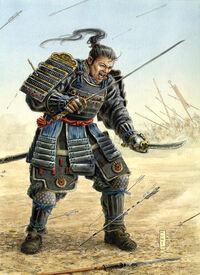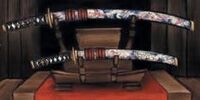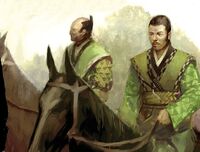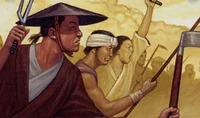
A Samurai
The Samurai, which means servant, [1] were the highest rank in the Rokugani social system, as decreed by the Celestial Order. The Samural were the warriors of Rokugan, as well as its nobles and rulers. [2]
Samurai and the Celestial Order[]
The social order of Rokugan was divided mainly into three groups, each of which supported the Empire in different ways.
There was also a fourth, "non-group";
- Hinin, or "non-people"
Meaning[]
The word "samurai" means "those who serve", and was was first used by Emperor Hantei in reference to the Seven Thunders before the Day of Thunder. [1] All who were born in this caste were considered samurai, regardless of their occupation. Female samurai were referred to as samurai-ko. [3]
Daisho[]

A Daisho
Only samurai were allowed to wear the daisho, a symbol of their office. The daisho consisted of a set of two blades, a wakizashi and a katana, tucked into an obi. Only true samurai would carry such weapons, and any individual caught carrying or touching a daisho without permission would be executed. [2]
- For further information on this section, please see Daisho
Bushido[]
Samurai lived by a code of conduct called Bushido. This complicated system governed all of a samurai's actions. [4]
- For further information on this section, please see Bushido
Samurai Justice[]
All samurai were entitled to a trial if they were brought up on any charges by another samurai. Charges brought against a samurai from a lower caste were generally ignored unless the samurai wished to acknowledge them. This did not mean that a samurai was always immune to punishment. Killing another lord's farmer would harm that lord's income, and the samurai had in a way commited a crime against that lord, and would probably have to face justice. A samurai who stole an apple from a peasant however, was unlikely to recieve any punishment. [2]
Sub Sections[]
The samurai caste was divided into a strict hierarchy.
Emperor[]
The Emperor of Rokugan was a member of the samurai caste, and held it's highest position. He owned all the land in the Empire, and allowed those who owed him fealty to manage these lands for him. The Emperor was also the head of Rokugan's spirituality, and was believed to be the voice of the Celestial Heavens. [2]
- For further information on this section, please see Emperor of Rokugan
Kuge[]
The Kuge were the most elite of the samurai caste. They were landed nobility and occupied powerful offices within the government. The Emperor was the highest member of the Kuge, and ranking just below him were functionaries such as the Voice of the Emperor, the Emerald Champion, the Jade Champion, the Imperial Chancellor and the Imperial Advisor. A special case was that of the rank of Shogun, who ranked just above the rest of the Kuge, but just below the Emperor. [5]
- For further information on this section, please see Kuge
Buke[]

Emerald Magistrates
The majority of samurai were members of the Buke, those who were not awarded lands or titles but served other samurai. These samurai were normally allowed to bear the name of their house; as an example few members of the Matsu family were actual, direct descendants of Matsu. Below these in rank were the vassal families, such as the Ikeda vassal family of the Matsu family. The highest ranking members of the Buke served as provincial governors, hatamoto, karo, city governors, Emerald Magistrates and so forth. Other offices such as the myriad tasks involved in a garrison, a castle keep or the support and ordering of a legion were the province of lower ranking samurai. The lowest of the Buke were the Ji-Samurai, or "half samurai". [5]
- For further information on this section, please see Buke
- For further information on this section, please see Ji-Samurai
Ronin[]
The lowest of the ji-samurai were ronin, who were samurai by birth or circumstance who had no lord to serve. These men and women almost always invoked distrust and disgust among other samurai. [6]
- For further information on this section, please see Ronin
Ashigaru[]

Ashigaru
The absolute lowest of the Buke, even below ji-samurai were Ashigaru. They were career soldiers, technically peasants, but more trained than an average farmer or carpenter in combat skills. While not equal to samurai on the field at all, they were skilled warriors in their own right. Ashigaru did not wear daisho, but were allowed to carry weapons in the course of their duties. Many ashigaru families served their lord for generations. [6]
- For further information on this section, please see Ashigaru
See also[]
References
- ↑ 1.0 1.1 Roleplaying in the Emerald Empire, p. 20
- ↑ 2.0 2.1 2.2 2.3 Legend of the Five Rings; Third Edition, p. 26
- ↑ Roleplaying in the Emerald Empire, pp. 24-25
- ↑ Roleplaying in the Emerald Empire, p. 24
- ↑ 5.0 5.1 Legend of the Five Rings; Third Edition, p. 27
- ↑ 6.0 6.1 Legend of the Five Rings; Third Edition, p. 28
| This article is a stub. That means that it has been started, but is incomplete. You can help by adding to the information here. |